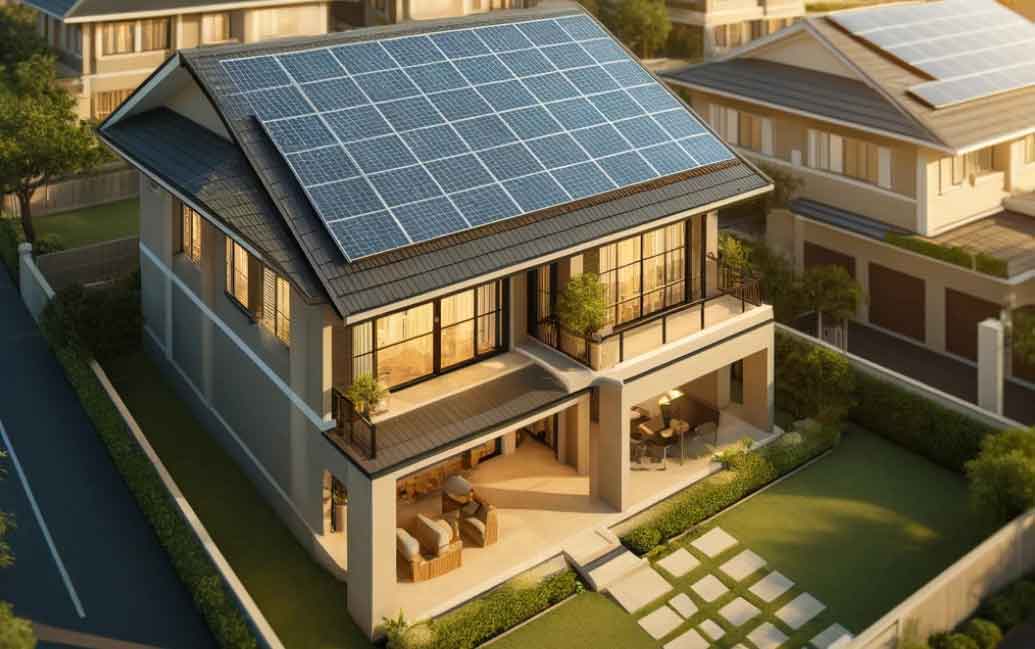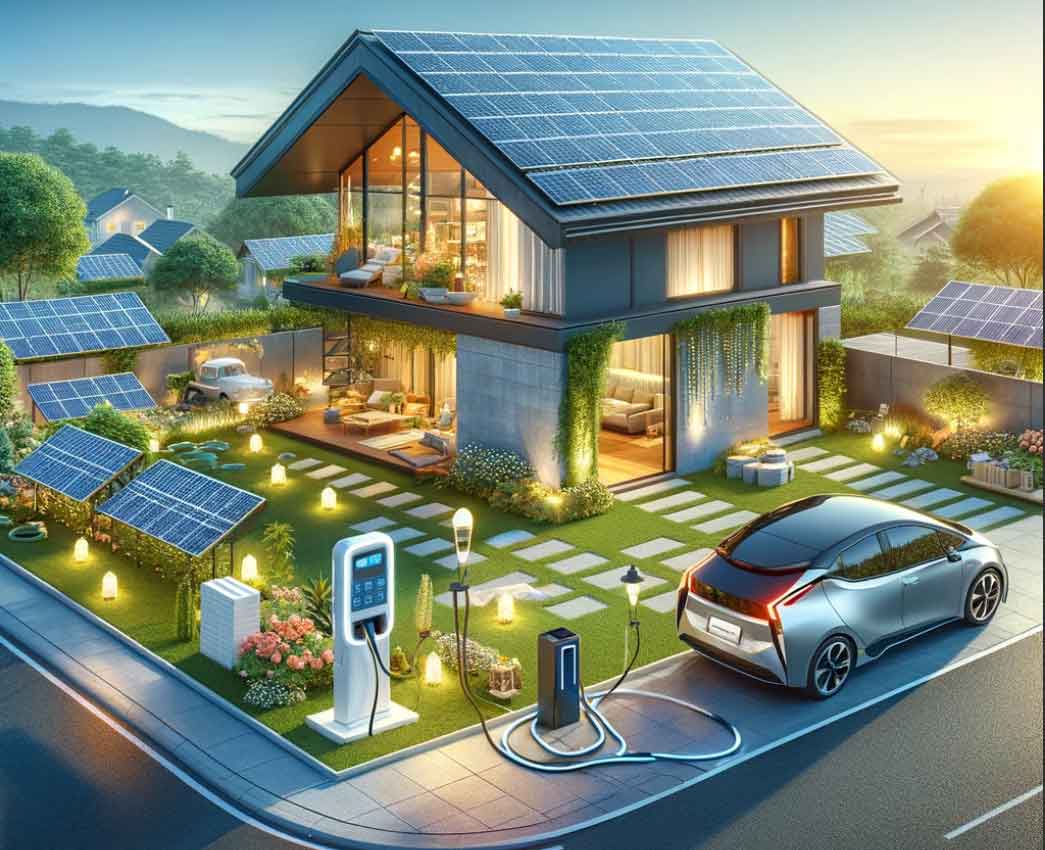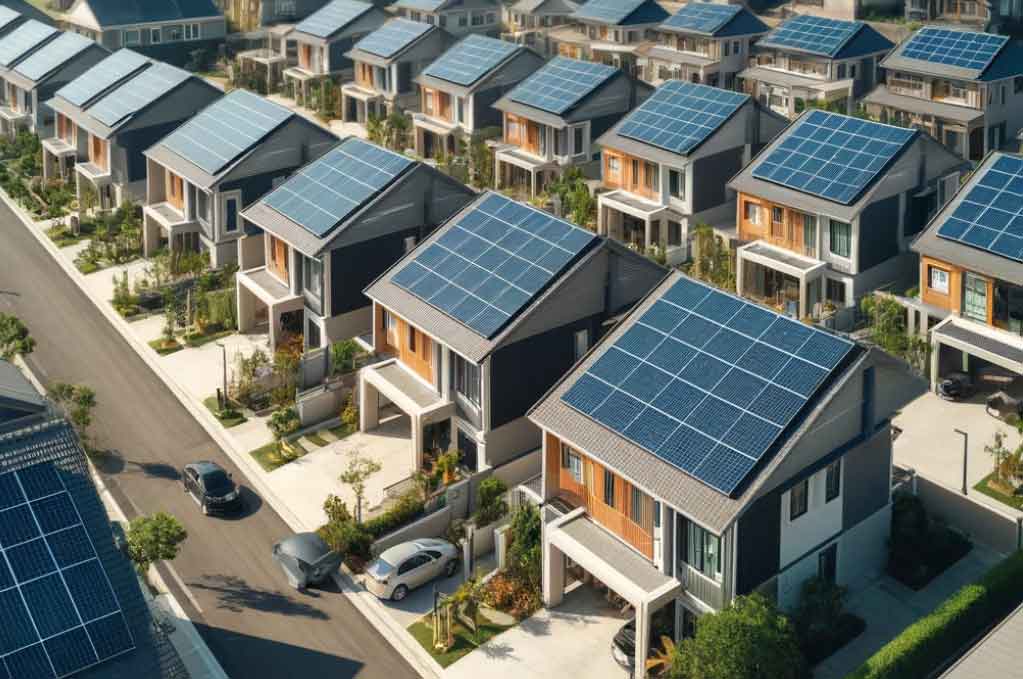Chapter 1: Why 10kW Solar System is Smart Choice for Your Home

Installing 10kW solar system for your home can be a smart choice for several reasons:
- Energy Independence: A 10kW solar system can significantly reduce your reliance on the grid. This is especially beneficial in areas with frequent power outages or in rural locations where grid electricity is less reliable.
- Cost Savings: 10kW Solar System can lead to substantial savings on electricity bills. While the initial investment might be significant, the long-term savings can be considerable. A 10kW system can generate a substantial amount of electricity, potentially offsetting a large portion of your energy usage.
- Environmental Impact: 10kW Solar System is clean and renewable. By choosing solar power, you’re reducing your carbon footprint and contributing to a reduction in greenhouse gas emissions.
- Increased Property Value: Homes with solar installations often see an increase in property value. Buyers are increasingly interested in homes with sustainable features, and 10kW Solar System can be a compelling selling point.
- Government Incentives: Many governments offer incentives for solar panel installation, such as tax credits, rebates, and feed-in tariffs. These can significantly reduce the cost of installation and improve the return on investment.
- Energy Production during Peak Hours: 10kW Solar System typically produce the most electricity during the middle of the day, which often aligns with peak electricity rates. This means you can save more money by producing your own electricity when it’s most expensive to purchase from the grid.
- Technology Advancements: 10kW Solar System technology has advanced significantly, increasing the efficiency and longevity of solar panels. Modern panels can generate more electricity in a variety of weather conditions and last longer than older models.
- Low Maintenance Costs: 10kW Solar System require relatively little maintenance, mostly just regular cleaning and occasional checks by a technician.
- Scalability and Flexibility: If your energy needs change, 10kW Solar System can often be expanded. This is particularly useful if you plan to increase your energy consumption in the future (e.g., by purchasing an electric vehicle).
- Net Metering: In many places, net metering allows you to sell excess electricity back to the grid, further reducing your energy bills or even earning you money.
In conclusion, 10kW solar system can offer long-term financial benefits, increase energy independence, reduce environmental impact, and potentially increase the value of your property. It’s important, however, to consider your specific energy needs, location, and the potential for solar energy production when deciding if 10kW Solar System is right for your home.
Chapter 2: 10kW Solar System: The Comprehensive Guide
Installing 10kW solar system can be a significant investment, but it also offers the potential for substantial savings and a good return on investment (ROI) over time. Let’s break down the key aspects:
Costs
- Initial Investment:
- The cost of a 10kW solar system varies depending on your location, the quality of the panels, and the complexity of the installation.
- As of my last update, the average cost in the U.S. was around $2.50 to $3.50 per watt, making the total cost range from $25,000 to $35,000 before any incentives or rebates.
- Incentives and Rebates:
- Federal tax credits, state-level incentives, and local rebates can significantly reduce the upfront cost.
- The federal 10kW solar system tax credit, for example, allows you to deduct a percentage of the cost from your federal taxes.
Savings
- Reduction in Energy Bills:
- A 10kW system can generate significant electricity, often enough to cover a substantial portion of a household’s energy needs.
- Savings on electricity bills can vary depending on your location, electricity rates, and 10kW solar system efficiency.
- Net Metering:
- Net metering policies allow you to sell excess energy back to the grid, earning credits on your utility bill.
- This can further enhance savings, especially in regions with high sunlight exposure.
ROI
- Payback Period:
- The payback period is the time it takes for the savings from your 10kW solar system to equal its initial cost.
- Typically, a 10kW solar system has a payback period of 5 to 10 years, depending on factors like installation cost, energy rates, and incentives.
- Increased Property Value:
- Solar installations can increase your property value. Homes with 10kW solar system often sell faster and at a premium compared to those without.
- Long-Term Benefits:
- 10kW solar system have a lifespan of 25-30 years, meaning you can enjoy reduced electricity costs for many years after the initial payback period.
- Environmental benefits, like reduced carbon footprint, are also significant ROI aspects for many homeowners.
Factors to Consider
- Solar Panel Quality and Warranty: Higher-quality panels with good warranties may cost more initially but can offer better long-term reliability and efficiency.
- Energy Usage: Understanding your household’s energy consumption can help in sizing the system correctly.
- Local Climate and Solar Insolation: Areas with more sunlight will naturally yield more energy.
- Roof Suitability: The condition, size, and orientation of your roof can affect the system’s efficiency.
Conclusion
10kW solar system can be a financially sound and environmentally friendly investment, especially when you factor in the long-term savings and potential incentives. It’s essential to conduct a thorough cost-benefit analysis, considering your specific circumstances and local conditions, to understand the full scope of the investment and its benefits.
Chapter 3: Families Powering Their Homes with 10kW Solar System

Families who power their homes with 10kW solar system engaging in a sustainable and increasingly cost-effective way to meet their energy needs. Here’s how such a system impacts a typical household:
Energy Production and Usage
- Energy Generation: 10kW solar system produces, on average, about 10,000 watts of power under ideal conditions (full sun). Actual production varies based on location, weather, and the system’s efficiency.
- Daily and Annual Production: Depending on location, a 10kW system can generate between 30-50 kWh per day. Annually, this can translate to around 11,000 to 18,250 kWh, although this will vary with geographic location and weather patterns.
Meeting Household Energy Needs
- Coverage of Energy Needs: The average U.S. household uses about 877 kWh per month (or about 29 kWh per day). Therefore, a 10kW system can fully cover, or even exceed, the typical energy requirements of a household.
- Energy Independence: Families can achieve a significant degree of energy independence, reducing reliance on the grid. In some cases, they may be entirely off-grid.
Financial Benefits
- Savings on Utility Bills: With the ability to meet most or all of their energy needs, families can see a substantial reduction, or even elimination, of their electricity bills.
- Net Metering: If net metering is available, surplus energy can be sold back to the grid, potentially earning the household credits on their utility bill.
- Tax Incentives and Rebates: Depending on the location, families might be eligible for state, federal, or local incentives that can offset the cost of installation.
Environmental Impact
- Reduction in Carbon Footprint: 10kW solar system is a clean, renewable resource. By using solar panels, families significantly reduce their carbon footprint, contributing to environmental sustainability.
- Support for Renewable Energy: Adopting 10kW solar system technology also supports the broader shift towards renewable energy sources, which is crucial for combating climate change.
Considerations for Installation
- Space Requirements: A 10kW system typically requires a significant amount of space, often around 600-800 square feet of roof area.
- Roof Suitability: The condition, orientation, and angle of the roof affect the system’s efficiency.
- Maintenance: While 10kW solar system generally require minimal maintenance, regular checks and cleaning can optimize their performance.
Long-term Aspects
- Durability and Warranty: Solar panels are durable and typically come with a warranty of 25-30 years.
- Property Value Increase: Homes with 10kW solar system can see an increase in property value, often viewed favorably in the real estate market.
In summary, families using a 10kW solar system can enjoy energy independence, financial savings, and a reduced environmental footprint. This choice represents not only an economic investment but also a commitment to a more sustainable lifestyle.
Chapter 5: Installing and Maintaining a 10kW Solar System

Installing and maintaining 10kW solar system involves several key steps and considerations to ensure optimal performance and longevity. Here’s a breakdown of the process:
Installation Process
- Site Assessment:
- An initial evaluation of your property, including roof condition, orientation, shading, and local climate, is essential.
- This assessment helps determine the most efficient layout and positioning of the panels.
- Design and Planning:
- Based on the assessment, 10kW solar system design is created, tailored to your energy needs and property characteristics.
- Necessary permits from local authorities and utility companies are obtained during this phase.
- Choosing Equipment:
- Selecting the right solar panels, inverters, and mounting systems is crucial. Factors like efficiency, durability, warranty, and cost are considered.
- In a 10kW system, you typically need about 20-40 solar panels, depending on their individual wattage.
- Installation:
- Professional 10kW solar system installers will mount the panels on your roof or on the ground, install the inverter, and set up the electrical systems.
- The system is then connected to the grid if you’re not going off-grid.
- Inspection and Connection:
- Post-installation, a local government representative usually inspects the system to ensure compliance with electrical codes.
- After passing inspection, the system is connected to the grid.
Maintenance and Monitoring
- Regular Inspections:
- Regular inspections, ideally annually, help in early detection of potential issues like loose mountings or shading from new vegetation.
- Cleaning Panels:
- Solar panels should be kept clean from dust, dirt, and debris for optimal performance.
- Cleaning frequency depends on your location; areas with more dust or bird activity may require more frequent cleaning.
- Monitoring System Performance:
- Most 10kW solar system come with monitoring software that allows you to track energy production and ensure everything is working efficiently.
- Monitoring can also alert you to any issues or drops in performance.
- Servicing and Repairs:
- In case of a drop in performance or any visible damage, professional servicing and repairs should be sought.
- Warranties often cover major repairs, but regular maintenance can prevent many issues.
- Battery Maintenance:
- If your system includes energy storage, battery maintenance is also important. This includes ensuring they’re kept at the right temperature and monitoring their health.
Additional Considerations
- Weather Considerations: In areas with extreme weather, additional protective measures like guards against hail or heavy snow might be necessary.
- Upgrades: Technology in 10kW solar system evolves rapidly. Keep an eye out for new advancements that could enhance your system.
- Safety: Always prioritize safety in maintenance. It’s usually best to hire professionals for tasks like cleaning high rooftop panels or dealing with electrical components.
By following these guidelines, your 10kW solar system should operate efficiently and provide sustainable energy for many years, significantly contributing to energy savings and reducing environmental impact.
Chapter 6: 10kW Solar System: Combining Efficiency with Sustainability
10kW solar system represents a sweet spot where efficiency meets sustainability. It’s a robust system size for many households, offering significant energy generation while promoting eco-friendly practices. Here’s an overview of how a 10kW system combines these elements:
Efficiency Aspects
- High Energy Production:
- A 10kW system can generate approximately 30-50 kWh per day, depending on geographic location and weather conditions. This is typically sufficient to cover the energy needs of an average household, and often more.
- Advanced Technology:
- Modern solar panels and inverters are highly efficient. The latest technologies ensure maximum conversion of sunlight into electricity, with efficiencies upwards of 20% for some panels.
- Optimized Energy Usage:
- Smart energy management systems can be integrated to optimize energy consumption. This includes using energy during peak production hours and storing excess energy in batteries for use during low production periods.
- Reduction in Energy Loss:
- Shorter energy transmission distances (from the rooftop to where it’s used) significantly reduce energy loss, which is a common issue in traditional power grids.
Sustainability Features
- Renewable Energy Source:
- 10kW solar system is a clean, renewable resource. By harnessing the sun’s energy, a 10kW system significantly reduces reliance on fossil fuels, contributing to a reduction in greenhouse gas emissions.
- Lower Carbon Footprint:
- By generating electricity without burning fossil fuels, 10kW solar system directly reduce the carbon footprint of a household. Over its lifetime, a 10kW solar system can offset tons of CO2.
- Energy Independence:
- 10kW solar system contribute to energy independence both at a household and community level, reducing the strain on the local grid and contributing to a more sustainable energy landscape.
- Support for Green Technologies:
- Investing in 10kW solar system helps drive the market for sustainable technologies, encouraging further innovation and cost reductions in renewable energy sectors.
Economic Benefits Tied to Sustainability
- Reduced Energy Bills:
- By producing your own electricity, you can significantly cut down on utility bills. This is an immediate financial return that complements the system’s environmental benefits.
- Government Incentives:
- Many governments offer incentives for solar panel installation, like tax credits or rebates, reflecting a push towards sustainable energy solutions.
- Increased Property Value:
- Homes equipped with 10kW solar system have been shown to increase in value. This is not only an economic benefit for the homeowner but also reflects the growing market demand for sustainable living solutions.
- Long-Term Savings:
- Despite the upfront cost, the long-term savings on energy bills and the durability of the system (often 25-30 years) make it a financially sound investment.
Conclusion
10kW solar system is an embodiment of how technological efficiency and sustainability can go hand-in-hand. Not only does it provide a practical solution to energy needs, but it also represents a commitment to an environmentally responsible lifestyle, all while offering substantial economic benefits over the long term.
